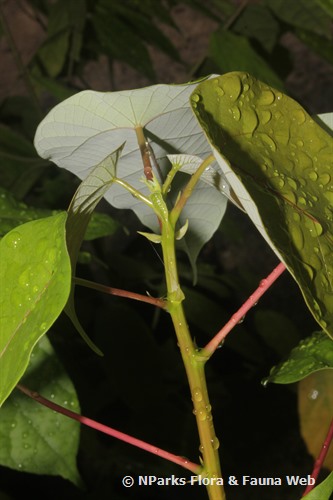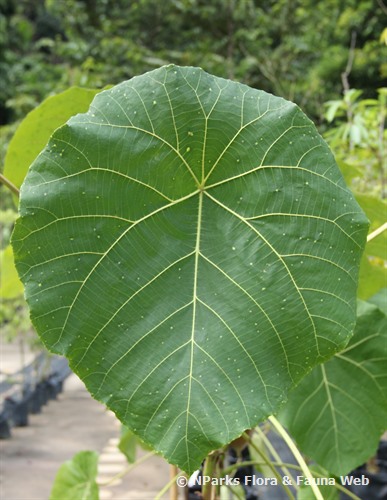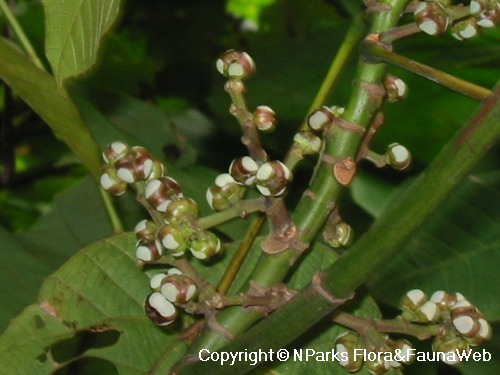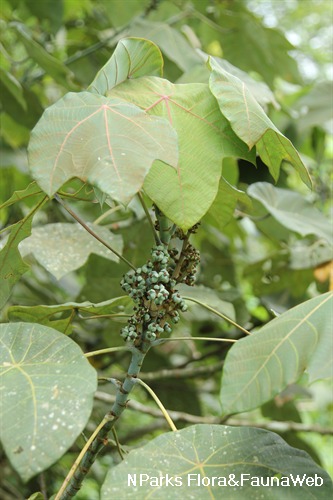
Back
Macaranga hullettii King ex Hook.f.
| Family Name: | Euphorbiaceae |
| Common Name: | Balik angin, Mahang bulan |
Name
Classifications and Characteristics
| Plant Division | Angiosperms (Flowering Seed Plants) |
|---|---|
| Plant Growth Form | Tree (Medium (16m-30m)) |
| Plant Shape | Irregular |
Biogeography
| Native Distribution | Peninsular Thailand, Sumatra, Peninsular Malaysia, Singapore, and Borneo |
|---|---|
| Native Habitat | Terrestrial (Primary Rainforest, Secondary Rainforest) |
| Preferred Climate Zone | Tropical |
| Local Conservation Status | Native to Singapore (Critically Endangered (CR)) |
Description and Ethnobotany
| Growth Form | It is a tree with hollow twigs, and can grow up to 18 m tall. |
|---|---|
| Foliage | Its alternate leaves have its stalks attached to the underside of the leaf blades. Its leaf blades are narrowly egg-shaped to egg-shaped, 14–32 by 6–22 cm, and usually with smooth margins, or sometimes slightly 3-lobed. |
| Flowers | Its tiny greenish flowers develop in flowering shoots (inflorescences) that occur in the leaf axils. Its male inflorescences are 10–30 cm long while female inflorescences are 4–10 by 2–5 cm. |
| Fruit | Its tiny greenish flowers develop in flowering shoots (inflorescences) that occur in the leaf axils. Its male inflorescences are 10–30 cm long while female inflorescences are 4–10 by 2–5 cm. |
| Habitat | It grows in primary and secondary forests, usually along streams, up to 1350 m altitude. It occurs locally in Pulau Tekong. |
| Associated Fauna | It is the preferred local food plant for the caterpillars of the butterfly, the Malay baron (Euthalia monina). Ants can also inhabit its hollow twigs. |
| Cultivation | It can be propagated by seed. |
| Etymology | Macaranga may be derived from a local name in Madagascar, or from Sanskrit words that mean body of monkey; Latin hullettii, commemorating Richard William Hullett, a 19th century headmaster, explorer, and plant collector of East and Southeast Asia |
| Ethnobotanical Uses | Others: A decoction of the plant are consumed by some tribes for stomach ailments. |
Landscaping Features
| Landscaping | It may be able to tolerate conditions along roadsides and parks. Based on its preference for streamsides, it is likely to be tolerant of wet ground. |
|---|---|
| Landscape Uses | Suitable for Roadsides |
Fauna, Pollination and Dispersal
| Fauna Pollination Dispersal Associated Fauna | Butterfly Host Plant |
|---|
Plant Care and Propagation
| Light Preference | Full Sun |
|---|---|
| Water Preference | Moderate Water |
| Plant Growth Rate | Moderate |
Foliar
| Mature Foliage Colour(s) | Green |
|---|
Floral (Angiosperm)
| Flower Colour(s) | Green |
|---|
Fruit, Seed and Spore
| Mature Fruit Colour(s) | Green, Green - Light Green, Yellow / Golden |
|---|
Image Repository
Others
| Master ID | 32985 |
|---|---|
| Species ID | 7399 |
| Flora Disclaimer | The information in this website has been compiled from reliable sources, such as reference works on medicinal plants. It is not a substitute for medical advice or treatment and NParks does not purport to provide any medical advice. Readers should always consult his/her physician before using or consuming a plant for medicinal purposes. |




.jpg)

